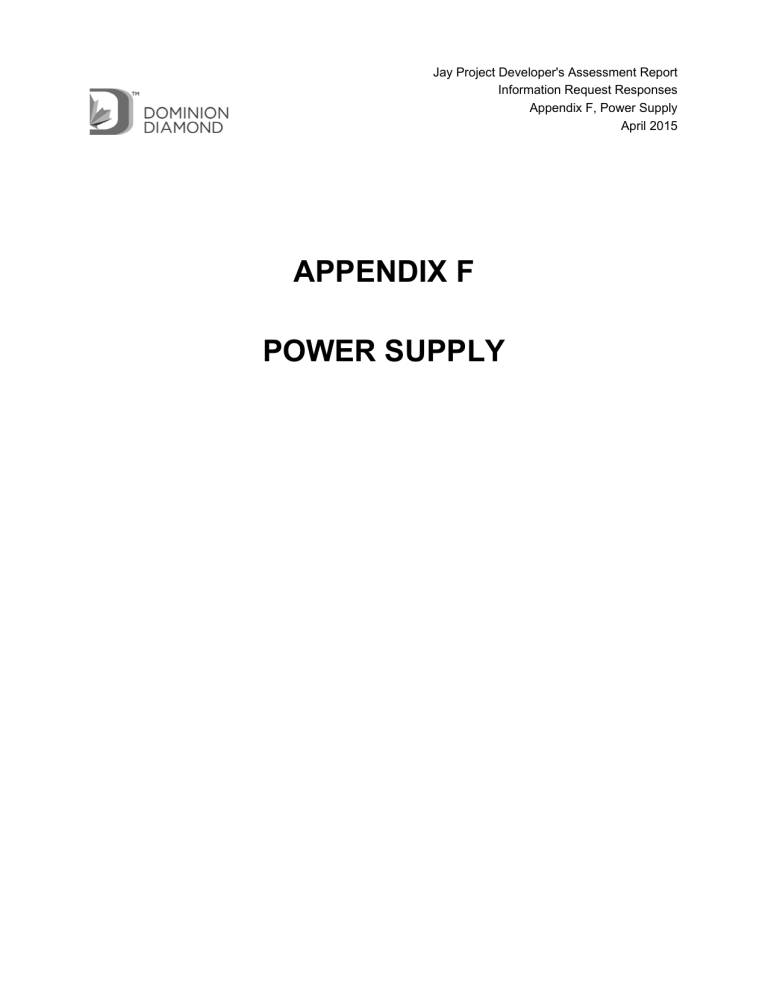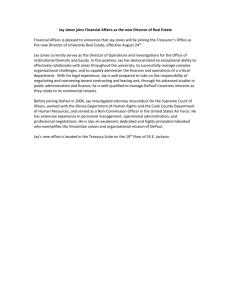appendix f power supply - Mackenzie Valley Review Board

Jay Project Developer's Assessment Report
Information Request Responses
Appendix F, Power Supply
April 2015
APPENDIX F
POWER SUPPLY
Jay Project Developer's Assessment Report
Information Request Responses
Appendix F, Power Supply
April 2015
Table of Contents
F1 INTRODUCTION .................................................................................................................................... 1
F2 BACKGROUND ..................................................................................................................................... 1
F2.1
Terms of Reference – Alternative Assessment (Power Supply) ...................................................... 1
F3 CURRENT AND FUTURE POWER SUPPLY REQUIREMENTS ......................................................... 2
F3.1
Current Ekati Power Supply ............................................................................................................. 2
F3.2
Jay Power Supply Requirements ..................................................................................................... 2
F4 POWER SUPPLY ALTERNATIVE ASSESSMENT .............................................................................. 2
F4.1
Supplemental Power Supply Considerations (for future consideration) .......................................... 5
Tables
Table 4.1
Summary Comparison of Alternative Energy Sources ....................................................... 4
F-i
Abbreviation
DAR
Dominion Diamond
Ekati Mine
IR
Project
TOR
Abbreviations
Definition
Developer's Assessment Report
Dominion Diamond Ekati Corporation
Ekati Diamond Mine
Information Request
Jay Project
Terms of Reference
Units of Measure
Unit
MW
Definition megawatt
Jay Project Developer's Assessment Report
Information Request Responses
Appendix F, Power Supply
April 2015
F-ii
Jay Project Developer's Assessment Report
Information Request Responses
Appendix F, Power Supply
April 2015
F1 INTRODUCTION
Several Information Requests (IRs) were received that have similar questions relating to potential alternate power supply sources for the Jay Project. Requests generally relate to:
• cost benefit analysis of wind power as a supplemental power source;
• cost benefit analysis of natural gas, hydroelectric, and biomass as alternative energy sources for full or partial power supply; and,
• analysis of payback for solar and wind renewable energy systems when used in conjunction with diesel generation.
This document has been prepared to provide a collective response to these inquires. IRs specifically which this document addresses, in no particular order, are:
•
DAR-MVEIRB-IR-75;
•
DAR-MVEIRB-IR-76;
•
DAR-NSMA-IR-11; and,
•
DAR-GNWT-IR-1.
F2 BACKGROUND
As discussed in the Project Description (Section 3 of the Developer’s Assessment Report [DAR]), the proposed Jay Project (Project) will be an extension to the existing Ekati Diamond Mine (Ekati Mine). Most of the facilities required to support the development and extraction of diamond-bearing kimberlite from the
Jay kimberlite pipe and to process the kimberlite currently exist at the Ekati Mine and the intent is to utilize these facilities wherever possible. Section 3.4 of the DAR further discusses the existing infrastructure, facilities, and operational management plans that will support the Project.
F2.1 Terms of Reference – Alternative Assessment
(Power Supply)
The alternatives assessment (Section 2 of the DAR) was conducted following the outline in the Revised
Terms of Reference (TOR) Section 7.3.4 (MVEIRB 2014). The requirements of the TOR included consideration of alternative energy sources and conservation methods for the Project. Dominion
Diamond’s approach to the assessment was to evaluate reliable energy sources that could provide the full power requirement needed for the Project.
F-1
Jay Project Developer's Assessment Report
Information Request Responses
F3 CURRENT AND FUTURE POWER SUPPLY
REQUIREMENTS
Appendix F, Power Supply
April 2015
F3.1 Current Ekati Power Supply
The Ekati Mine powerhouse currently has seven 4.4 megawatt (MW) diesel generators for a total installed generating capacity of 30.8 MW. Waste heat from the power plant is recovered by means of glycol heat exchangers to heat buildings and process water.
Construction of a power distribution line was initiated in 2014 to provide power from the Ekati Mine powerhouse to the Misery camp and facilities for existing operational needs. The installation of the power line between Ekati and Misery will provide operating and environmental efficiencies resulting from centralized power generation. Completion and activation of the power line (planned for 2015) will allow the Misery generators to be taken off-line and used only in a backup capacity.
F3.2 Jay Power Supply Requirements
The Jay Project activities at the Jay Pit area are estimated to require approximately 3 MW of power during dewatering period and up to 2 MW during Jay open pit operations. The existing Ekati Mine powerhouse has capacity to provide this power to the Jay Pit area while continuing to provide for the other essential power requirements of the Project (e.g., processing plant, Ekati main camp). The complete power requirement for the Project will be in the order of 20 to 25 MW on average.
F4 POWER SUPPLY ALTERNATIVE ASSESSMENT
Dominion Diamond has received DAR IRs that have questioned why alternative energy sources such as wind, biomass (burning of natural organic material, typically wood, to produce electricity), hydroelectric, natural gas, and solar power were not considered in the alternatives assessment. In general, these energy sources were not included because they would either require development of new infrastructure that would be cost prohibitive to the Project, and/or they could not reliably provide the full power requirements for the Project needs on a year round basis.
The energy source alternative that was identified as the preferred alternative for the Project in the alternatives assessment was to use the existing power generating and distribution facilities at the Ekati
Mine. No modification or refurbishment of the Ekati Mine powerhouse is anticipated to accommodate the
Project. The only infrastructure required would be to connect the Misery power line to the necessary locations in the Jay Pit area such that efficiencies of centralized power generation continued to be realized.
Use of biomass, natural gas, or hydroelectric power would require substantial capital investment to construct or modify infrastructure for these energy sources and would require new infrastructure to support fuel storage and/or generation facilities. In addition, biomass and natural gas would require more trucking to move fuel to the site because they are less efficient fuels than diesel. This would put higher demands on the Tibbitt to Contwoyto Winter Road (TCWR) and would result in higher greenhouse gas emissions for transport. Also, it may not be feasible to produce the full power requirement for the mine from these power sources, such that they would only be supplemental sources to diesel power generation. This is discussed further in Table F-1 below.
F-2
Jay Project Developer's Assessment Report
Information Request Responses
Appendix F, Power Supply
April 2015
Dezé Energy, a joint venture formed between the NT Energy, the Akaitcho First Nation, and Northwest
Territory Métis Nation, evaluated the feasibility of supplying hydroelectric power to Ekati, Diavik, and
Snap Lake mines (Talston Hydroelectric Expansion Project). This project was put on hold as the energy requirements and collective mine life were not sufficient to support financing and construction of the hydroelectric expansion project (CBC 2011). The Environmental Assessment for the project was terminated in July 2013 (NT Energy 2013a).
Wind and solar power installations that might provide the full power requirement would be cost prohibitive because of the very large infrastructure requirements and could also be schedule-prohibitive because of the long lead times for procurement of such large infrastructure. Additionally, wind and solar installations in the order of 20 to 25 MW are unproven in the Canadian North. For these reasons, wind and solar would not be able to provide reliable full time power for the Jay Project and could only be considered for supplemental power.
Photovoltaic panels convert sunlight directly into electricity. The first utility-scale hybrid solar photovoltaic panel project is scheduled for construction in Colville Lake in 2015. This demonstration project is designed to provide 81 kW and will test the benefits of a hybrid system that will integrate a solar power array with a diesel/battery plant (NT Energy 2013b). The success of this project will influence the use of photovoltaic systems for other projects, such as supplemental power for communities. The very high installation costs of photovoltaic systems would make it cost prohibitive for the Project which has a mine life of approximately 10 years, which is relatively short in this context.
The Northwest Territories Energy (03) Corporation Ltd. (NT Energy) is the Government of the Northwest
Territories (GNWT) lead energy project developer (GNWT 2013). NT Energy assists the GNWT in meeting its overall energy objectives and is the project leader for the Northwest Territories (NWT) Power
System Plan that provides a 20-year outlook for developing the necessary infrastructure to transform electricity supply to communities, business, and industries in the NWT. The NWT Energy Action Plan
(GNWT 2013) and Power System Plan (NT Energy 2013b) provide very relevant information regarding the feasibility and applicability of alternate energy sources in the NWT. Information from these documents was used to populate a comparison of alternative energy sources in Table F-1. Some of these alternative power sources would not be feasible to replace diesel power generation and would only be able to supplement diesel power generation.
F-3
Jay Project Developer's Assessment Report
Information Request Responses
Appendix F, Power Supply
April 2015
Table F-1
Energy Source
Diesel – use existing
Ekati Power house
Summary Comparison of Alternative Energy Sources
Potential to provide total power requirements of the
Project?
Could be considered for
Supplemental Power in the future?
Hydroelectric
Biomass
Liquified Natural Gas
Solar
Wind Turbines
Yes
No
Yes
Yes
No
No n/a
No
No
No
No
Yes
Advantages
•
Infrastructure is in place, very minimal capital cost associated with construction of a Jay Pit power line to connect the Misery power line
•
Reliable
•
Easy to inspect and maintain using existing resources
•
Proven methodology
•
Diesel required on site regardless (for mobile equipment)
•
Some GHG emissions associated with flooding to create reservoir
•
No GHG emissions, associated with generation
•
No cost for fuel supply – water
•
Lower GHG emissions
•
•
Lower GHG emissions
Lower fuel price than diesel
•
Lower GHG emissions (solar power is only supplemental – diesel still required)
•
No fuel cost (sunshine)
•
Lower GHG emissions (only supplemental – diesel still required)
•
No cost for fuel (wind)
Disadvantages
•
Higher greenhouse gas (GHG) emissions than some other alternatives (ongoing transport and burning)
•
Cost of diesel fuel
•
Environmental risks related to long-haul trucking of diesel fuel (hazardous material)
•
No local source of hydroelectric energy
•
Creates new environmental risks and impacts
•
Often seasonally variable
•
Is not economically viable for this project (fatal flaw); as discussed above, Dezé Power assessed a regional infrastructure project which was determined to not be feasible and was terminated in 2013
•
Requires construction of new infrastructure (power plant and storage), which would be cost prohibitive to Jay Project
•
No source of biomass nearby
•
Requires more transport trucks on the TCWR leading to higher demand on road and higher GHG for transport
•
Need qualified individuals to operate power-generation-sized boilers
•
Biomass typically produces small electrical and heating loads which are normally insufficient to achieve the scale required for economically viable combined heat and power plants
•
Biomass fuel supply can be costly, especially when transport and storage is considered, and achieving a stable long-term supply can be difficult
•
Would still require diesel power generation due to uncertainty in finding a source that can supply the required biomass fuel volume or if all the biomass fuel can’t be stored on site to get through the period when there is no road access to site
•
Due to fuel inefficiency and long transport, deemed unsuitable for supplemental power for Jay Project
•
Would require construction of new infrastructure (power plant) to supply full power or retrofit with “bi-fuel” kit to allow generators to operate using a blend of natural gas and diesel fuel to supplement diesel; both of these capital expenditures would be cost prohibitive to Jay Project
•
Costly construction of liquid natural gas (LNG) storage tanks if LNG is used during periods when the site does not have road access
•
Requires more transport trucks on the TCWR leading to higher demand on road and higher GHG for transport
•
May still require diesel power generation depending on ability to transport and store sufficient volumes of LNG on site
•
Very high installation costs
•
Intermittent supply – dependant on length and intensity of sunshine; due to northern latitude and low light conditions for extended periods of the winter, unable to provide sufficient power as a supplemental source
•
Low return on investment, difficult to make economic case for payback over a 10-year period
•
Diesel still required
•
Would require construction of new infrastructure
•
Long lead times for procurement
•
Intermittent and variable supply – dependant on wind direction and speed
•
Limits to operational temperatures
•
Relatively new energy source for a northern location
•
Not a proven reliable energy source over long term for a northern location; Diavik has had good success with wind power generation during the first couple of years of operation of their wind farm, indicating good potential
•
Potential hazard to birds
•
Noise pollution has the potential to affect other wildlife
•
Diesel still required
F-4
Jay Project Developer's Assessment Report
Information Request Responses
Appendix F, Power Supply
April 2015
F4.1 Supplemental Power Supply Considerations (For Future
Consideration)
Based on the summary of information in Table F-1, wind energy is the most likely supplemental energy source that could be economically feasible for the Jay Project.
Dominion Diamond is aware that Diavik has constructed four wind turbines (9.2 MW total) and is gaining operational experience to better understand the feasibility of wind power for Northern industrial projects and the potential for diesel fuel savings. Rio Tinto reports that in 2014 wind power provided 19.9 gigawatt hours, equivalent to 11 percent of the Diavik Mine’s annual power requirement (Rio Tinto 2015).
The Jay Project does not significantly change the peak loads of the Ekati Mine, and as such, it does not require new investment in power supply in the short term. The Jay Project does, however, lengthen the
Ekati Mine life, providing additional time to amortize investments in alternative power supply. Dominion
Diamond will continue to evaluate the technical and economic feasibility of alternative power supply options in view of this benefit.
F5 REFERENCES
CBC. 2011. http://www.cbc.ca/news/canada/north/taltson-hydro-expansion-put-on-hold-1.1027782
GNWT (Government of the Northwest Territories) 2013. Northwest Territories Energy Action Plan.
December 2013.
MVEIRB (Mackenzie Valley Environmental Impact Review Board). 2014. Revised Terms of Reference
EA1314-01 Jay Project. Dominion Diamond Ekati Corporation. July 17, 2014
NT Energy (Northwest Territories Energy Corporation (03) Ltd.). 2013a. Talston Expansion Project
Termination Letter. July 2013.
NT Energy. 2013b. A Vision for the NWT Power System Plan. December 2013.
Rio Tinto. 2015. Innovative and efficient wind farm delivers http://www.riotinto.com/ourcommitment/features-2932_12151.aspx
F-5







